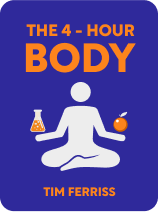

This article is an excerpt from the Shortform book guide to "The 4-Hour Body" by Timothy Ferriss. Shortform has the world's best summaries and analyses of books you should be reading.
Like this article? Sign up for a free trial here .
What is the body recomposition diet? How can a recomp diet help you improve your body?
In The 4-Hour Body, Tim Ferriss discusses the use of a body recomposition diet. After a first wave of weight loss with the Slow-Carb Diet, Ferriss recommends using a body recomposition diet for building muscle.
Read more about the body recomposition diet recommended for building muscle in The 4-Hour Body.
Body Recomposition Diet
While working out according to Occam’s Protocol, follow the Slow-Carb Diet but include the following additions for the recomp diet:
- Drink half a shake in the morning and before bed. To make the shake, combine:
- 5 ice cubes
- 3 cups milk (2% or whole organic)
- 1 banana
- 30g whey protein isolate
- 3 heaping tablespoons almond butter
- Add starch to the meals without shakes.
- Optional: If you’re struggling to gain muscle mass, this body recomposition diet suggests you drink up to four liters of 2% organic milk daily, between meals. Milk increases fat gain, so start with just a liter per day. If you’re lactose intolerant, start with one glass of organic whole milk per day—after a couple of weeks, drinking milk may be comfortable. (Shortform note: We recommend consulting your doctor first.)
If you’re not gaining at least 2.5 pounds of muscle a week, you probably need to eat more. You need to eat 20 calories for every pound of your lean body weight plus an extra 200 calories per day. Count calories for one day to make sure you’re not accidentally undereating.
If you have trouble eating enough, soldier on—your body just needs some time to adjust to the changes for the body recomposition diet to work. If the problem is that you have trouble eating a lot at once, eat smaller portions more often instead. Or, try liquid food instead of solid, such as shakes, which is especially helpful for those who have trouble with breakfast.
- For example, bodybuilder Dave Palumbo couldn’t eat any more food without throwing it up. He blended his food and then stayed still for 15 minutes to let his body settle.
Protein on the Recomp Diet
As part of your quest to eat a lot on the body recomposition diet, make sure you eat a lot of protein. To build muscle, you should eat 1.35 grams of protein for every pound of lean body weight. For example, if you weigh 120 pounds and your body fat percentage is 15%, 18 pounds of your body is fat. Subtract 18 pounds from 120 to get 102 pounds: your lean body weight. Multiply 102 by 1.35 to get 127.5 grams of protein.
While popular belief says the human body can’t process more than 30 grams of protein in a single sitting, this is untrue. It’s fine to either eat protein throughout the day or eat it all once. Researchers in France found that for 26-year-old women, it didn’t matter if the protein was consumed all in one sitting or throughout the day; the body handled either method just fine. Older subjects actually retained the protein better if they ate it all at once.
Supplements
You don’t have to take supplements with body recomposition diet—it works fine on its own—but if you’d like to, the author has four recommendations:
- Cissus quadrangularis. This medicinal plant is usually used for joint repair, but when the author was taking it after elbow surgery, he noticed that it also stopped him from gaining weight. He took 2.4 grams half an hour before eating, three times a day, and didn’t gain weight even though at that time in his life, he was eating a lot of rice and sugar.
- Alpha-lipoic acid. See Chapter 7 for more detail on its uses.
- L-glutamine. This amino acid helps repair tissue, notably the intestines, which need to be in good working order to process all the food you have to eat as part of the protocol. For the first five days of the protocol, consume 10 grams every two hours until you reach 80 grams. On subsequent days, optionally consume 10-30 grams after each workout.
- Creatine monohydrate. This compound increases protein synthesis, as well as the force of muscle. Have 5-20 grams daily, 3.5 grams when you wake up and before bed daily.
Troubleshooting
Like any program, there are challenges with following Occam’s Protocol. Here are some of the common problems people encounter and how to fix them:
Problem #1: You miss a workout because of travel. If you have to miss a workout, take the time as a rest day rather than trying to do a partial or adjusted workout. If you travel a lot, consider using free weights instead of machines because most gyms have standardized versions.
Problem #2: You miss the minimum number of reps. Failing to complete reps happens for two reasons: You didn’t eat or rest enough, or you stopped too early and didn’t push yourself to total failure. If you miss by more than one rep on the first exercise, stop and take a rest day before trying again—don’t change the weight or make an adjustment. Take an extra rest day between all future workouts.
Problem #3: You feel the 5/5 cadence makes you slower in other athletic pursuits. There’s no evidence to suggest that using a slower cadence will make you slow in general. In fact, there’s evidence to the contrary: In 1973, a high school weightlifting team trained by doing slow negatives and were very successful at Olympic weightlifting, which requires a lot of speed. As long as you don’t let weightlifting get in the way of your other training, you’ll be fine.
Problem #4: You want to change the protocol. This program is designed to help you gain 10 or more pounds of muscle in a month. If you have a different goal, choose a different program.
Problem #5: You want to train less often. Some trainers suggest training only once or twice a month. This technique is more helpful for strength gain than size gain. To gain size, you need to eat a lot and use exercise to encourage insulin to deliver glucose to muscles rather than fat. If you only train once or twice a month, you can’t eat as much.

———End of Preview———
Like what you just read? Read the rest of the world's best book summary and analysis of Timothy Ferriss's "The 4-Hour Body" at Shortform .
Here's what you'll find in our full The 4-Hour Body summary :
- How to do the least amount you need to do for the results you want
- Why you need a cheat day in your diet
- How to improve everything about your body, including sleep, sex, and longevity






